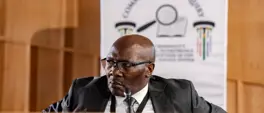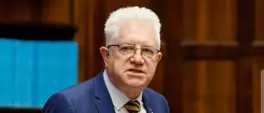Eleanore Bouw Spies | Paying millions for failure: SA's SOE salary scandal
Guest contributor
7 November 2025 | 8:55'South Africa has approximately 700 SOEs in total, and to date, a significant portion of these have not disclosed their executive compensation figures in response to parliamentary inquiries by DA members in Parliament,' writes Eleanore Bouw Spies.
- State-owned enterprises (SOEs)
- Passenger Rail Agency of South Africa (PRASA)
- Financial Sector Conduct Authority (FSCA)
- Road Accident Fund (RAF)
- Government Employees Pension Fund (GEPF)
- South African Revenue Service (SARS)

Picture: @Dotransport/X
Earning millions while costing the taxpayer billions. This is the status quo of the comfy chief executive eofficer (CEOs) of South Africa’s failing state-owned enterprises (SEOs).
These billions lost go to waste when they could have been used for service delivery and job creation which our citizens so badly need.
Almost R500 million is spent on CEO salaries at 117 SOEs.
To put it into perspective: it currently costs government approximately R255,364 to build a single BNG (Breaking New Ground or formerly RDP) house in South Africa. This means that R500 million could build around 1,960 BNG houses, providing homes for roughly 8,000 South Africans, assuming an average of four people per household.
Alternatively, consider that the new specialised Pretoria Head and Neck Hospital — a 100-bed facility with five theatres is being built at a cost of R450 million. In other words, the same R500 million could fund the construction of an entire specialised hospital.
South Africa has approximately 700 SOEs in total, and to date, a significant portion of these have not disclosed their executive compensation figures in response to parliamentary inquiries by Democratic Alliance (DA) members in Parliament.
The actual figure is likely to be considerably higher once all SOE compensation figures are finally accounted for.
This spending demands scrutiny, especially given the financial position at these entities. Taxpayers have forked out an estimated R521 billion over the last 15 years to keep SOEs afloat through government bailouts. Yet even with these continuous substantial investments, many entities still face financial challenges stemming from mismanagement and corruption.
In 2024 alone, South African SOEs reported R169.91 million in fruitless and wasteful expenditure. These entities are officially operating under considerable financial strain. Against this financially constrained backdrop, SOE CEOs continue to earn exceptionally high salaries.
Now, CEO salaries have always been high, whether in the public or private sector, because executives carry significant risk and responsibility for an organisation's success or failure. When an organisation performs well and meets its objectives, executives are appropriately rewarded through compensation, bonuses, incentives and perks.
But what happens when organisational performance drops?
In the private sector, due process is followed to examine how the organisation reached its challenging point. Where necessary, leadership changes are considered, and new strategic plans are developed by the board so that underlying issues can be diagnosed. When an executive fails to meet performance expectations, transitions are made, and new leadership is brought in. This accountability framework is a cornerstone of how the private sector maintains performance.
South Africa's SOE landscape appears to be operating by different rules.
Here, the standard of performance-based accountability has not been consistentlyapplied. Salary disparities reveal a troubling pattern across our SOE landscape.
Salary packages for some SOE executives at the upper end of the salary spectrum often exceed or rival those of their private sector counterparts. The Development Bank of Southern Africa’s CEO earned R10.5 million in 2023/24, jumping to R15.5 million in 2024/25, a 48% increase in a single year.
The Government Employees Pension Fund’s principal executive officer received a base salary of R4 million, with additional allowances and retirement contributions bringing the total to R6.7 million. Add short- and long-term incentive bonuses totalling R3.2 million in 2023/24, the overall remuneration exceeded R9 million.
Again, CEOs earn high salaries. But what happens when these substantial packages exist alongside organisational underperformance?
This disconnect requires scrutiny when dealing with taxpayers' money.
Consider these examples: Transnet’ CEO earns R8.5 million annually, yet the entity has experienced significant operational failures requiring a R47 billion bailout from the State. The Passenger Rail Agency of South Africa (PRASA) pays its CEO R7.8 million in remuneration, even though PRASA has received audit disclaimers while experiencing widespread service collapse.
The Road Accident Fund’s (RAF) CEO pockets R7.1 million. Meanwhile, RAF is technically insolvent, their revenues cannot cover all immediately due lump sum payments, and their deficit has ballooned from R1.6 billion in 2024 to R2.3 billion in 2025.
Rand Water’s CEO remuneration package stands at R5.4 million. Yet Rand Water is facing water outages, service delivery and infrastructure failures, impacting South African households and businesses directly. Rand Water’s problems have long remained a central point of probes. In 2018, OUTA was already sounding the alarm, requesting reviews of bonuses paid to the then chief executive, Percy Sechemane, for the period 2014 to 2017.
These inflated salary examples raise important questions about the SOE remuneration frameworks and oversight. Many SOEs appear to be operating outside the remuneration guidelines established by the Department of Public Service and Administration. Entities like SARS, DBSA, and the Financial Sector Conduct Authority benchmark salaries against private sector norms. They claim to operate in “highly specialised industries” that require market-rate compensation. This approach creates multiple inconsistencies across the SOE landscape. Some entities follow strict public service salary scales while others operate with considerably more flexibility.
The consequence of this is executive compensation that appears disconnected from organisational performance outcomes. Whether an SOE requires State bailouts or operates efficiently, whether it prospers or struggles, salary levels remain elevated.
This disconnect between performance accountability and salary determination highlights the urgent need for reform in how executive remuneration is managedacross the SOE sector.
A framework without enforcement is merely a suggestion, and it seems like that’s exactly what SOE remuneration guidelines have become. Regardless of the Department of Public Enterprises (DPE) guidelines dating back to 2007 that cap executive pay based on organisational size and explicitly state that audit disclaimers should eliminate bonuses, we see the opposite in practice. Many SOEs ignore these rules. Some SOEs claim they’re essential and need to be paid private sector salaries.
The result?
Entities are collapsing while executives earn millions, all of which are funded by taxpayers. Until there are real consequences, SOE remuneration guidelines will just remain as just an expense on paper sponsored by taxpayers.
Eleanore Bouw Spies is the DA's spokesperson on Public Service and Administration
Get the whole picture 💡
Take a look at the topic timeline for all related articles.
Trending News
More in Opinion

12 November 2025 09:45
MALAIKA MAHLATSI: The DA’s Eleanor Bouw-Spies is entitled to her own opinions, but not to her own facts

12 November 2025 09:45
CHARLES MATSEKE | Blue Lights and blood money: The Cartelization of the South African state

7 November 2025 15:46
MALAIKA MAHLATSI | AWSISA Water and Sanitation Global South Dialogue is an opportunity for meaningful progress in SA













